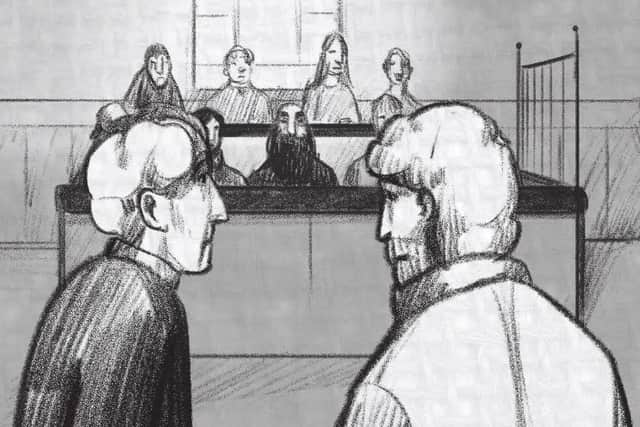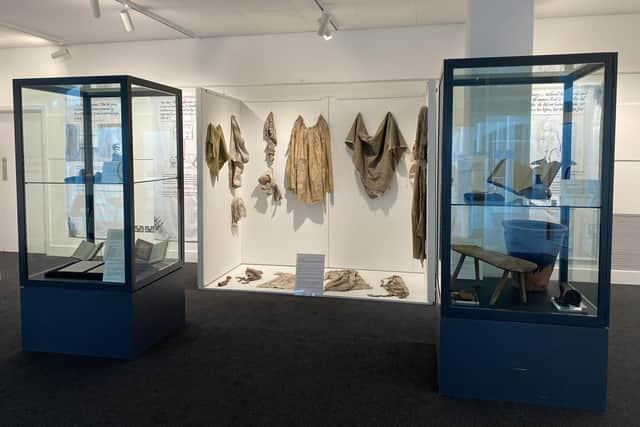Islandmagee witches: New exhibition uses virtual reality to bring story of the last witch trial in Ireland to life
and live on Freeview channel 276
‘Reimagining the Islandmagee Witches: an Interactive Exhibition’ utilises audio-visual and interpretative elements to tell the story of the 1711 trial of the Islandmagee witches in the east Antrim town.
They include a virtual reality experience, animation, a graphic novel, and a choice-driven video game, alongside a number of historical objects, maps, and written accounts.
Advertisement
Hide AdAdvertisement
Hide AdBelieved to have been the last witch trial to take place anywhere on the island of Ireland, eight women were put on trial and found guilty of exercising witchcraft on the body of young gentlewoman, Mary Dunbar.


Explaining how the women came to be accused of the crime, Shirin Murphy from Carrickfergus Museum said: “[Mary Dunbar] had arrived to Knowehead House, the home of her family, from Castlereagh. Very quickly after she arrived she started experiencing fits and convulsions, and went on to accuse eight woman and one man of bewitching her.
“The authorities took it seriously; the eight women were rounded up, put in chains and held in gaol.”
Tried under the Irish 1586 Witchcraft Act, the women – Janet Carson, Janet Latimer, Janet Main, Janet Millar, Margaret Mitchell, Catherine McCalmond, Janet Liston and Elizabeth Sellor – were found guilty by a jury at County Antrim’s Criminal Assize Court held in Carrick on March 31, 1711.
Advertisement
Hide AdAdvertisement
Hide AdThey were sentenced to a year’s imprisonment and to be pilloried four times on market day for six hours.


At a later trial on September 11, 1711 in the same court, William Sellor – father to Elizabeth Sellor and husband to Janet Liston – was also found guilty of Mary’s bewitchment.
However, Mary had died a couple of weeks after the first trial, turning William’s original crime into a felony for which the punishment was death by hanging.
‘Reimagining the Islandmagee Witches: an Interactive Exhibition’ opened on September 9, and runs until November 16.
Advertisement
Hide AdAdvertisement
Hide AdThe Museum has been working closely with a multi-disciplinary team from Ulster University to develop the initiative, with the research project led by Dr Helen Jackson, Dr Victoria McCollum and Dr Andrew Sneddon.
“The team at Ulster University have devised a number of creative outputs to allow a deeper engagement with the story,” Shirin said.
“With the VR experience, you put on the headset and you are in the Presbyterian meeting house, where you can watch some animation telling the story. You then move outside to stand in Islandmagee itself by the ‘witching stone’, which was a real place. At that point you can interact with a number of objects.”
In one section of the immersive VR experience, participants are transported to 18th century Carrickfergus, where the technology gives a glimpse of what it might have been like for a convicted criminal placed in the stocks.
Advertisement
Hide AdAdvertisement
Hide Ad"It is designed to be unsettling and to allow you to experience that feeling of being bewitched, but also what it might be like to be accused of those crimes,” Shirin added.
The immersive nature of the exhibition is continued in a video game, where players are invited to search an old cottage for evidence of witchcraft.
Alongside the interactive experiences, there are a number of physical artefacts on display, from earthenware and clay pipes to the manacles and leg irons that would have been used to restrain prisoners.
A publication by 19th century historian Samuel McSkimin, who edited a contemporary manuscript detailing the trials, gives a rare eyewitness account of the process.
Advertisement
Hide AdAdvertisement
Hide AdMeanwhile, an art installation by UU students reproduces some of the clothing that would have been worn by the accused, highlighting how the women were targeted in part due to their appearance.
Many of the objects on display come from Carrickfergus Museum’s own collection, with others loaned from National Museums Northern Ireland, National Library of Ireland and Belfast Central Library.
Coinciding with the opening of the exhibition at the weekend was a creative writing workshop, led by Kentuckian playwright and professor, Georgia Rhoades.
The workshop explored the lives of people whose experiences and viewpoints are often left out of historical accounts - beginning with the accused at Islandmagee.
Advertisement
Hide AdAdvertisement
Hide AdParticipants viewed the exhibition and discussed their responses to it before being invited to write about unexplored or forgotten people they were interested in, with the option of performing what they wrote and sharing it with the group.
Also on offer as part of the wider programme is a two-part lino print workshop, also designed to allow a deeper engagement with the ‘Reimagining the Islandmagee Witches’ exhibition.
It will explore the exhibition themes in more detail before participants can get hands on with lino printing, a style which aims to recreate the wood block prints of the early 18th century.
Those attending can learn the techniques and create their own piece of art.
Advertisement
Hide AdAdvertisement
Hide AdThe lino print workshops will take place on October 7 and 14; though aimed at age 16 plus, no experience is necessary.
Meanwhile, next month will see a series of performances when the tale of the Islandmagee witch trials will play out through live storytelling, enhanced with music and visual imagery.
Created by professional story-teller Vicky McFarland and musician Lee McFarland, the production is based wholly on Andrew Sneddon’s extensive research into the trial.
The 45 minute performance is suitable for those aged 12 and over.
Booking for all events is through Eventbrite; for further information on the events, call 028 9335 8241 or email [email protected].
